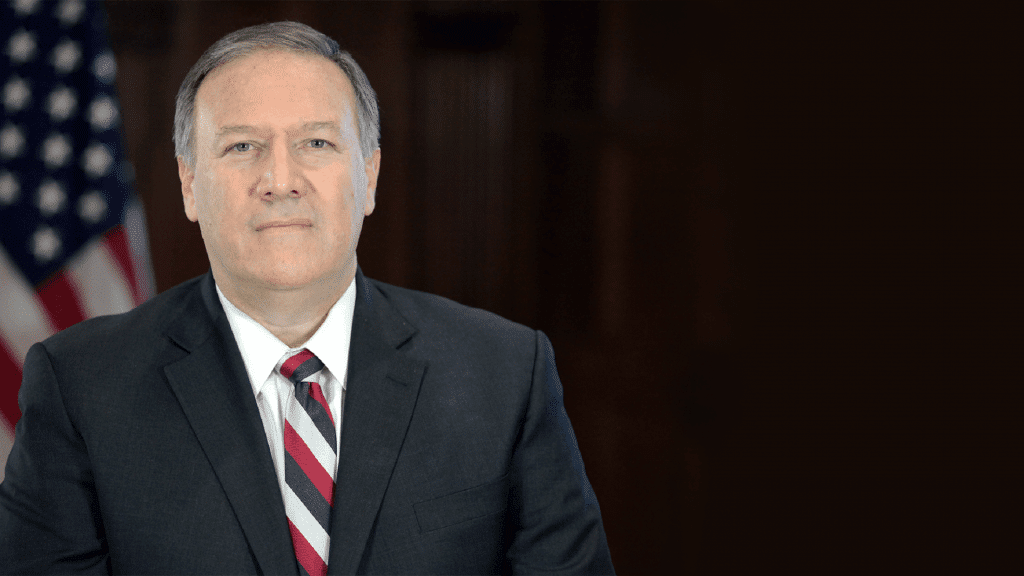Kim Jong-un’s long game
By Duyeon Kim | July 6, 2018
 Secretary of State Mike Pompeo
Secretary of State Mike Pompeo
Less than a month after the first-ever US-North Korea summit, news reports began emerging that Pyongyang is continuing to develop its nuclear program, just as it was doing before the June 12th meeting in Singapore between Donald Trump and Kim Jong-un. This shouldn’t come as a surprise. While these reported activities violate UN Security Council resolutions, nothing in the Singapore Joint Statement issued by the two leaders immediately prohibited nuclear activity, committed Pyongyang to ending its nuclear business as usual, or in any way altered the North Korean nuclear threat.
That all leaves US Secretary of State Michael Pompeo, who began nuclear negotiations in Pyongyang on Friday, facing a tough challenge. The four-point statement Trump and Kim Jong-un delivered after their summit only set broad goals. Pompeo now needs to deliver a genuinely historic nuclear deal, one that goes beyond what the Joint Comprehensive Plan of Action achieved on Iran before Trump withdrew the United States, and beyond the two prior international attempts to solve the North Korean nuclear threat, the 1994 Geneva Agreed Framework and the 2005 Six Party Talks Joint Statement and its two implementing agreements.
Pompeo’s task won’t be easy, in part because Trump—the self-proclaimed great negotiator—already skewed negotiations in Kim Jong-un’s favor by making important concessions in Singapore in the absence of a real nuclear deal or any verifiable denuclearization steps. Speaking at a post-summit press conference, Trump nonchalantly offered to eventually withdraw US troops from the peninsula and also to end US-South Korean joint military exercises, goals long sought by the North Korean regime. (These measures will surely please Beijing too.)
Pompeo faces other challenges, too. For America’s essential allies South Korea and Japan, the big question now is not just whether they can trust Kim but whether they can trust Trump. Another obstacle US negotiators will encounter is a deep difference in strategic outlook between the two countries’ leadership. Kim Jong-un is playing a long game, looking 40 to 50 years down the road. Trump, on the other hand, seems to be focused on the next 2.5 years, until the next US presidential election in 2020. That means Trump’s primary goal is anything that looks like a quick win, even though real denuclearization could take much longer. There is also the slim possibility that Kim Jong-un could make the strategic decision to denuclearize for now—determining that striking a deal with Trump is the best way to achieve economic prosperity—with plans to revive his country’s nuclear force at a later date, a possibility recently suggested by former South Korean National Security Advisor Chung Yung-woo. This sort of revival could happen if “denuclearization” covers only the physical and material destruction of Pyongyang’s nuclear programs, without a plan to deal with North Korean nuclear scientists and personnel and the knowledge they have.
Faced with this situation, a successful diplomatic process will depend on three things: First, whether North Korea agrees to declare all of its nuclear inventory and submit to intrusive verification measures; second, whether all sides can agree on a sequence for denuclearization, security guarantees, and peace; and third, whether Trump has the political commitment and patience to see this through. If diplomacy fails, and the Trump administration only manages to place a Band-Aid over the problem, the result could be an economically vibrant, nuclear-armed North Korea that enjoys normal relations with Washington.
Round one, Kim. The winner of the first round of negotiations in Singapore was undisputedly Kim Jong-un—and by extension, Chinese President Xi Jinping—because Trump revealed Washington’s ultimate bargaining card too soon: US troop withdrawal from Korea. Another major summit success for North Korea was that Trump accepted Pyongyang’s decades-old demand that the United States and South Korea cancel their joint military drills. Trump even characterized the defensive drills as “provocative” and “war games,” adopting Pyongyang and Beijing’s language. To be sure, the joint drills have been cancelled before, but that was in 1992, before Pyongyang had nuclear weapons and inter-continental ballistic missiles. The longer the soldiers do not train and exercise, the more their readiness declines, and the weaker the rationale becomes for justifying their presence on the Korean peninsula from Pyongyang and Beijing’s point of view.
Another win for Pyongyang was that the Singapore Summit Joint Statement fell short of past deals, particularly the October 2000 US-North Korea Joint Communique, which charted far more comprehensive ways that Washington and Pyongyang planned to fundamentally improve their relationship, deal with the nuclear and missile problems, and work towards a peace regime. It was clear before the Singapore summit that the two leaders would not strike a typical nuclear deal, but would agree on basic principles and outcomes to lay the groundwork for negotiations. That is, in fact, what happened: Singapore did not produce details on denuclearization, let alone a shared definition. It will be critical for Pompeo to work toward these goals in the second round of negotiations that began this week.
The toughest round: verification. With the aim of dazzling the international community, Pyongyang claimed to have taken several denuclearization measures already. It said it has halted nuclear and missile testing, destroyed the Punggye-ri nuclear test site, and dismantled the missile-engine test facility identified as the Sohae Satellite Launching Ground.
North Korea has not conducted nuclear or missile flight tests since 2017. Even so, this absence of testing does not constitute a genuine denuclearization step, because Kim announced back in January that he had “completed” his “state nuclear force” and will now mass produce nuclear warheads and ballistic missiles. If true, this means that testing and the corresponding facilities are no longer technologically needed in order for North Korea to continue producing weapons.
Meanwhile the “destruction” of Punggye-ri has already been contested widely, and commercial satellite imagery revealed by 38 North on June 21 showed “no apparent dismantlement activities at Sohae Engine Test Site as of June 12.” (The destruction of a static missile launch facility would in any case be meaningless because road-mobile launchers enable quick missile launches from various locations.) Neither of the other measures have been verified by international inspectors, and more fundamentally, technical experts say, all of the claimed measures could be reversed or reconstructed later.
The first real test of North Korea’s seriousness about denuclearization is yet to come. Pompeo must convince the regime to declare its nuclear weapons holdings and allow verification of its inventory and subsequent denuclearization steps. During the Six Party Talks, Pyongyang handed over more than 18,000 pages of documents related to its plutonium program, but the multilateral talks broke down in 2008 because of disagreements over a verification protocol. Now, a decade later, declaration and verification will have to be more intrusive and expansive because North Korea has made significant technological advancements on uranium enrichment, nuclear warheads, and long-range ballistic missiles. A team of inspectors from any of the five recognized nuclear weapon states will likely have to be created. Early signs of “sincerity” from North Korea could include verifiably dismantling some fissile material production facilities or allowing inspections of uranium enrichment plants that are currently unknown to the outside world. Washington will have to decide what security and political concessions it is prepared to provide in return for each denuclearization step, without compromising the security of the region.
Getting the sequence right. The future of the Korean Peninsula and the regional order will be impacted by decisions made in Pyongyang, Seoul, Washington, and Beijing on key issues. They will have to agree on the order in which critical steps take place, in particular the denuclearization process, security assurances, and the establishment of a peace regime on the Korean peninsula.
It is critical that complete denuclearization be achieved before signing a peace treaty, and that the US-South Korean alliance, which plays a vital role in the stability of the region, remain strong. A premature withdrawal of US troops from South Korea would significantly alter the power dynamic and destabilize the region while doing a disservice to American interests.
Can Trump go the distance? Finally, Trump’s political commitment and patience will likely be tested by the duration of the diplomatic process. The long process of concession-for-concession could reveal the Trump administration’s true goals: Does the White House wish only to address inter-continental ballistic missiles that are a threat to the United States, or to address Pyongyang’s entire nuclear weapons program, which remains a threat to allies South Korea and Japan? The worst-case scenario for Seoul and Tokyo would be if this process results in Pyongyang retaining a limited nuclear arsenal contingent upon forgoing future developments. If that happens, North Korea could virtually become another India (minus democracy): A nuclear-armed country that enjoys economic prosperity, a civil nuclear energy program, and normalized relations with Washington. Another bad outcome, particularly for some circles in Seoul, would be if North Korea does give up nuclear weapons, but in exchange, the United States withdraws all troops from the peninsula, leaving South Korea vulnerable to potential external threats from its neighbors.
The biggest difference today compared to the past 25 years of negotiating with Pyongyang is that Kim Jong-un—the North Korean leader himself—has written his name on this process. The negotiations will experience stumbling blocks, and there will be forces to derail diplomacy along the way. But as risky as the diplomatic process will be, a negotiated settlement is still the best option, provided negotiations are allowed to function properly and a future nuclear deal is implemented fully before either side calls it quits and says “I told you so.” This may also be our last diplomatic opportunity to seek a peaceful solution to the North Korean nuclear problem.
Editor’s note: Duyeon Kim was in Singapore for the June 2018 Trump-Kim summit as a one-time CBS News contributor providing live analysis and commentary.
Together, we make the world safer.
The Bulletin elevates expert voices above the noise. But as an independent nonprofit organization, our operations depend on the support of readers like you. Help us continue to deliver quality journalism that holds leaders accountable. Your support of our work at any level is important. In return, we promise our coverage will be understandable, influential, vigilant, solution-oriented, and fair-minded. Together we can make a difference.
Keywords: Kim Jong-un, North Korea, United States, nuclear weapons
Topics: Columnists, Nuclear Risk, Nuclear Weapons














